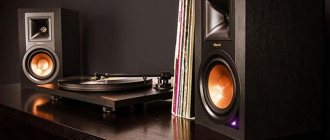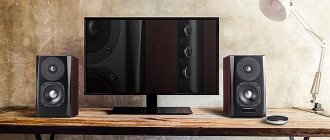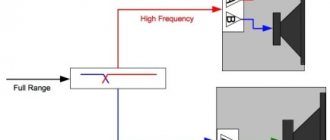According to Wikipedia, an acoustic system is “a device for reproducing sound, the final link of an amplification path.” In more detail, what it is can be described as follows - this is a set of special equipment that reproduces music or other sounds by converting electrical signals from the amplifier into mechanical vibrations of the speakers. More details about all the features and types of these audio systems are further in our material.
Purpose of the speaker
Acoustic systems (AS) sometimes mean speakers, loudspeakers, speakers. However, in fact, these are different concepts with certain differences and features. Loudspeakers are one or more speakers that convert incoming electrical signals into acoustic signals through air vibrations. The speaker combines several Hi-Fi and Hi-End loudspeakers with other equipment to produce higher quality sound .
The scope of application of speakers is quite extensive. Firstly, they are included in the kits of most electrophones, tape recorders and music centers. Secondly, audio systems are widely used in combination with electric musical instruments. Thirdly, these devices are an integral part of sound-reproducing equipment in cinemas and concert halls. Even just to amplify the sound of a microphone over large areas, speakers are used.
Design and principle of operation of speakers
Acoustic oscillatory systems, depending on the purpose of use, type of connection and other parameters, have design differences. However, they all consist of the following elements:
- frame;
- loudspeaker heads;
- filtering and correcting circuits (for example, overload protection, etc.);
- amplifiers (in some types);
- audio cables.
Housing and electronics
The housing not only serves as an aesthetic component of the main device, but also significantly affects the quality and intensity of the sound. For example, with low-frequency emissions, it eliminates the process of bass suppression. The design of the box also makes it possible to reduce resonances and reduce the unevenness of amplitude characteristics in the range of even medium and high frequencies.
The loudspeaker heads are mostly electrodynamic. They convert the received signals into mechanical vibrations due to the movement of a conductor (or coil) with alternating current, which is in a constant magnetic field. As a result, synchronous vibrations of the coil and the diaphragm attached to it occur, which leads to the appearance of sound pressure, perceived by the human hearing organs as sound in a certain range.
Filtering and correction circuits make the system more stable and efficient. To provide high-quality sound, several loudspeakers operating at different frequencies are used. Thanks to electrical separation filters (crossovers), each head is separately supplied with signals of the required sub-band. Passive filters are also used to control signal bandwidths, as well as digital filters, threshold circuits, and other equipment.
Amplifier
This is an additional speaker element, the purpose of which is to amplify the power of the incoming signal. The amplifier can be built into the speaker system body, or can be purchased separately . In the first case, this allows:
- do not participate in the process of matching the amplifier and emitter according to the necessary parameters (happens automatically);
- reduce the cost of the speaker system;
- Do not use a large cross-section cable.
The second option has the following features:
- the ability to service the amplifier separately if the entire system is located in a hard-to-reach place;
- for powerful speakers you can use one power supply, and not several, as in the case of the built-in option;
- There is no need to use a balanced connection when the sound source is very far from the speaker system.
Schematic diagram of operation
Having figured out what the speaker consists of, you can easily understand its operating principle. The electrical signal from the sound-reproducing device passes through special equipment, if necessary, it is amplified and filtered, and then fed to a loudspeaker. There, the electrical impulse is converted into mechanical vibrations of the diffuser, which cause corresponding air movements, which we perceive as a sound signal of a certain frequency. At the same time, the reproduced sound is high-quality, clear, powerful, intense, accurate and deep.
Characteristics of acoustic speakers
When choosing a speaker, you definitely need to pay attention to a number of its characteristics. The sound quality, device capabilities and service life depend on them.
The most important characteristics of the speakers:
- Efficient sound reproduction. The value of this characteristic is directly reflected in the natural sound of the system. Effective reproduction includes the range of frequencies within which the sound pressure level develops. When the operating range approaches the maximum value that the human ear perceives, the most natural sound occurs. Low frequencies are reproduced better the larger the sound system body.
- Uneven sound pressure. The sound quality depends on the broken curves with dips that the sound of the speaker system has. Speakers with direct sound pressure transmit sound best.
- Directionality. This characteristic is needed in order to place the speakers in the room as comfortably as possible for hearing. Directivity allows you to evaluate the distribution of sound around the perimeter of the room.
- Sensitivity. A parameter that determines the dynamic range of a particular speaker. The wider the range, the more complex sound the system can convey. Only speakers with a wide dynamic range can accurately convey the sound of a symphony or jazz.
- Distortion indicator. Using the distortion indicator, you can regulate all changes in the operation of the system that distort the sound reproduction. The higher the sound strength, the higher the distortion rate.
- Electric power. The characteristic gives an understanding of how strong the sound can be reproduced by a particular speaker in a room. Power varies from maximum to peak. The choice of amplifier power depends, first of all, on the desire of the buyer, but it is also worth considering the feasibility of installing speakers with a certain power in a certain room.
When choosing a speaker system, it is important to carefully study all its characteristics, since changing the characteristics built-in by the manufacturer is a difficult and expensive matter, and no one can give guarantees that the result will coincide with expectations.
Speakers Electronics
Advantages and disadvantages
Speaker systems are widely used not only for various events, but also for home listening to audio tracks. This is the main means by which you can enhance and improve the sound. Despite the wide variety of acoustic systems, they are all united by basic features, which are expressed in advantages and disadvantages.
Among the advantages are:
- improving sound quality and volume;
- the ability to select the appropriate speaker model depending on the purpose of use: sound level, power, functions and additional capabilities;
- ability to connect to additional devices for audio transmission;
- the presence of an accessible interface and remote control, which simplifies the setup and operation of the speakers;
- the ability to read different formats, which allows you to play audio tracks from different sources and storage devices.
The disadvantages of audio systems in most cases come down to their high cost, size (in some models the speakers are quite large) and a large number of cables . However, at home, the problem of lack of free space can be solved by purchasing portable acoustics, for example, in the form of a sound bar. Such equipment can be purchased, including in stores that sell office equipment and other electronics.
Whereas professional high-power speakers of RMS, DIN, PMPO standards will consist of very solid acoustic speakers and a separately connected amplifier. But for large stages and areas these dimensions do not play any significant role. Such acoustics are called component acoustics, as they consist of several elements.
Advice! For home and car use, it makes sense to purchase a coaxial speaker, all of whose components are mounted in one housing.
What types of acoustic systems are there, and how do they differ from conventional musical electronics?
Built-in acoustics is a set of equipment that is installed during the renovation of a room and built into the walls, ceiling, or furniture (most often cabinets). It is not always possible to install such equipment if the apartment has already been renovated, so it is recommended to plan the purchase of equipment in advance. The main thing you should pay attention to is the dimensions of the equipment, since it may not fit into some cavities. Built-in systems are installed taking into account the dimensions and location of the room, the equipment is installed in such a way as to obtain optimal sound. The advantages of such acoustics include the absence of additional dust collectors, hidden installation, and attractive room design.
Classification and features of different types
Today there are a large variety of different models on the speaker system market. Conventionally, speakers can be divided into different groups, classified by types of acoustics and installation methods, number and type of components, purpose, bandwidth, power, sensitivity, frequency, case material, interfaces and a host of other characteristics. Below - in more detail about the main classification criteria.
Passive and active
As mentioned above, all acoustics are divided into passive and active. In the active version, the amplifier is built into the housing. Such models are portable, compact, and easy to adjust settings. And by connecting the speakers directly to the amplifiers, the sound quality is improved and the range of reproduced frequencies is expanded. Whereas for passive systems a separate external amplifier is needed.
On a note! When using passive speakers, connecting a linear signal and voltage to each speaker is not required.
Wideband and multiband
The quality and richness of the sound depends on the number of bands. From one to seven stripes can be used. In the first case, a wideband system is used, where one speaker produces the entire spectrum of audible frequencies (high, mid and low) - type 1. This includes monitor and front speakers.
In general, for individual frequencies it is better to use speakers of different designs so that there is no overlap or distortion of the sound. Therefore, two-way and three-way systems are more in demand. In the first case, one emitter reproduces low and medium frequencies, and the other high frequencies. In the second case, each of the 3 loudspeakers produces one of three subranges. In this option, the sound quality will be significantly better than wideband.
Central, rear and front
Each component of the speaker system has its own name and purpose. Elements can be purchased separately or together, which will create a completely immersive effect. Of all the components of the speaker system, the following components are most in demand.
- The center channel system is a device that transmits voices, most sound and music, and also provides sound-image binding. Therefore, such speakers are placed in close proximity to the image source (above or below the screen) and are used for surround sound.
- The front system is the speakers that reproduce the main sound. They are located in front of the sound reproducing device and can work either independently or as part of a multi-channel speaker system.
- The rear system serves for the effect of “surrounding sounds”, that is, it creates a background. Therefore, such speakers are placed above the head, behind or to the side of the listeners. You can even turn it towards the wall so that the sound reflects off it.
On a note! A variation of the rear group are bipolar speakers, equipped with two sets of speakers placed at an angle of 90 ° to each other.
Floor and shelf
Depending on the intended installation methods, there are floor, wall, shelf and ceiling systems. Floor-standing speakers are usually the most massive and heaviest, for example, a subwoofer. Shelf devices are small in size and can be conveniently placed on top of furniture (soundbar). Wall-mounted speakers also have compact dimensions, but unlike bookshelf options, they come with mounting hardware. Small rear speakers can be hung on the side of the wall or in front under the ceiling to create background noise around the listener.
Subwoofer and tweeters
A subwoofer is a single-way powerful unit that transmits low-frequency sounds. If you already have front speakers or tweeters, a subwoofer can really improve the sound. Moreover, when specifying the type of speaker, the subwoofer comes separately . For example, if it is stated that the system is 5.1, then this means that it includes 5 speakers of different frequencies and a subwoofer.
High frequencies can also be played separately - on tweeters. Such speakers are installed on top of the front ones.
Soundbars
In the context of space and space saving, so-called sound bars have become especially popular. This is a kind of sound panel, in the horizontal case of which there are speakers of different sound ranges. Many people wonder what they are for. Such a shelf system does not take up much space, does not clutter the room with a large number of speakers and looks very stylish on a shelf under or above the TV, while providing decent quality.
Closed and open
The speakers also differ in the design of the housing.
Important! There are open and closed systems: in the first case, the back panel is missing or perforated, and in the second, it is a hermetically sealed box.
Electrostatic
Electrostatic speakers use a thin film of conductive material stretched around the perimeter, which receives an electrical signal at the frequency of sound. Under the influence of a constant magnetic field, the film moves and begins to vibrate, producing an audible sound.
Other varieties
Other types of closed speaker systems are also quite common. They use additional elements to improve the power and sound of the bass.
- In horn speakers, a horn (pipe) is used to concentrate and broadcast sound signals.
- In a speaker with a bass reflex, resonance is ensured from the back to the front side of the diffuser, which leads to an increase in the power of the resulting sound.
- Instead of a bass reflex, a passive radiator can be used.
- Also, to highlight the bass, an acoustic labyrinth is used, which is a kind of bass reflex, but with its length and curvature more reminiscent of a labyrinth.
As follows from the above, a speaker system is a very extensive type of audio equipment, from the many models and options of which each user will be able to select speakers that meet individual requests and needs.









